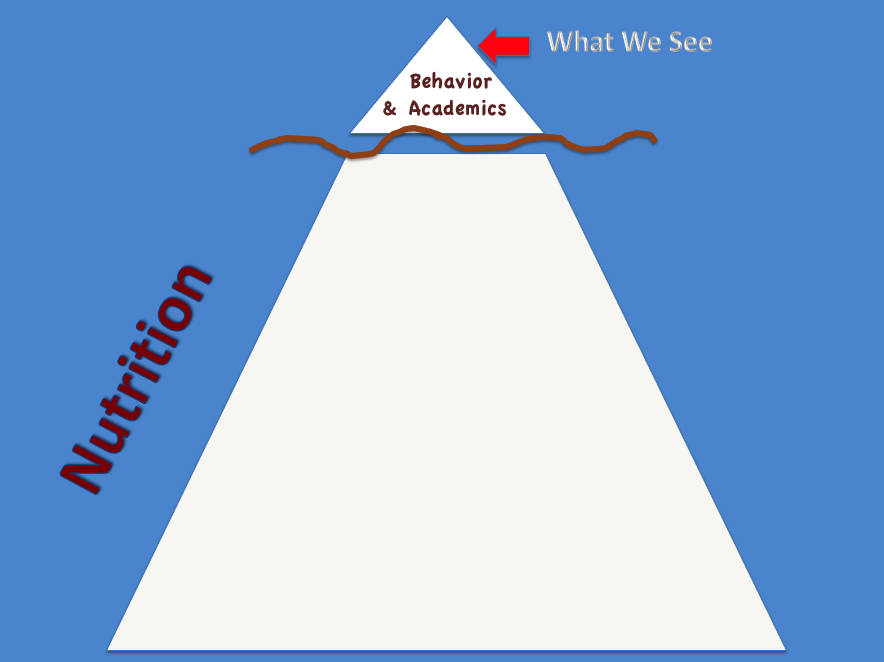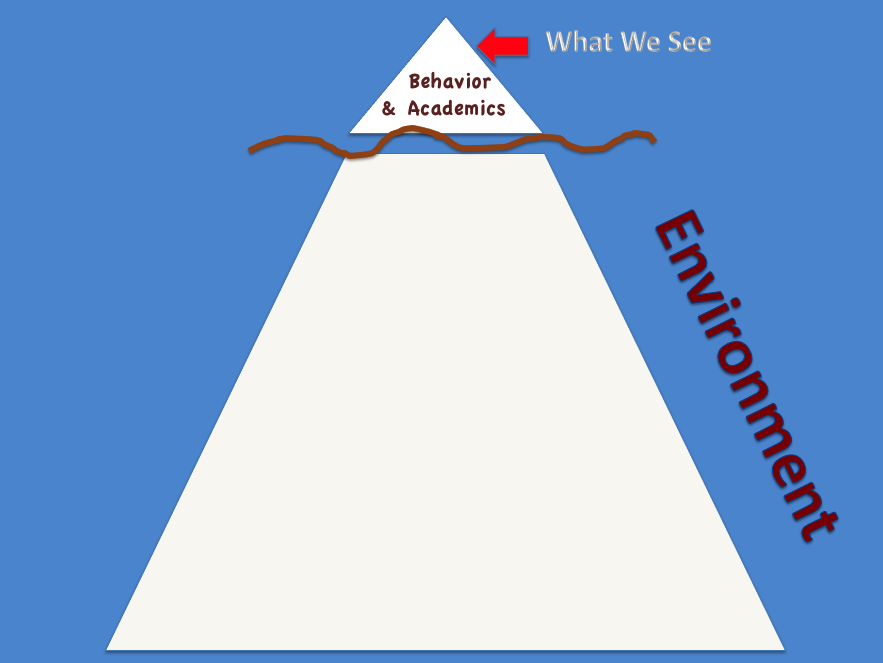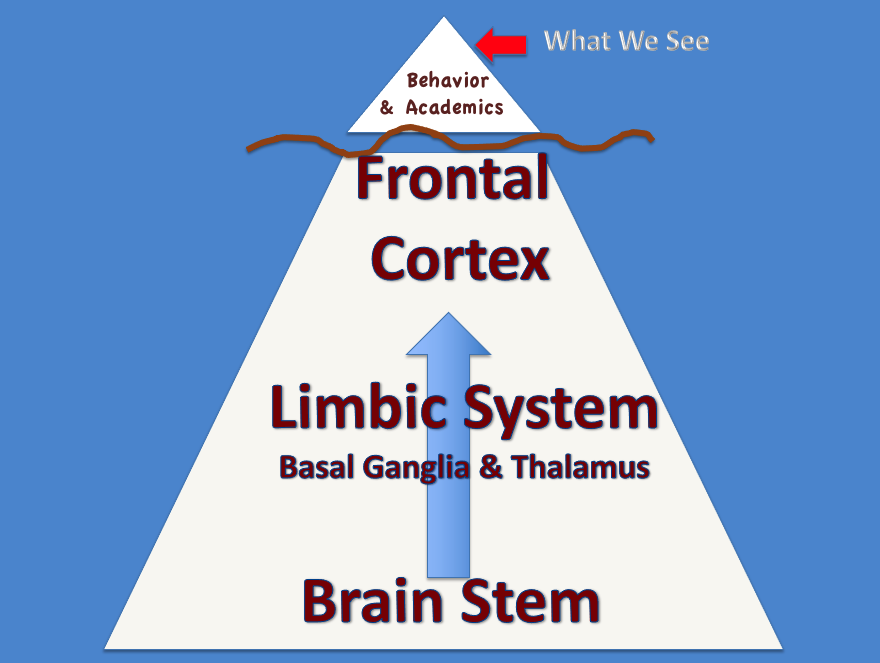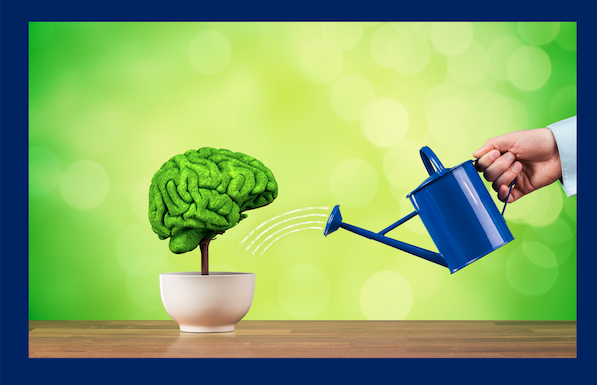I like to think of brain development by using the analogy of an iceberg. Behavior and academics, how well students perform in school, and how they behave, is what the parent and teacher sees. However, there is so much that underlines it. Like an iceberg, we are only seeing the tip. There are so many structures that need to be developed and in place before students can demonstrate strong academics and positive behavior.
Step 1: Nutrition

The structure of the brain is bathing in the sea of the nutritional environment of which it receives. As your child grows and develops, it is critical to ensure that they have enough vitamins, minerals, Omega 3, probiotics, and other essential nutrients. At the same time, you need to avoid harmful foods, such as colors, chemicals, and artificial flavors. Then, we also have to acknowledge that when we are nursing or are pregnant we may have food sensitivities that we are passing through to our unborn child, or that there are sensitivities the baby is developing without our awareness. Chronically exposing ourselves or children to chemicals or foods with which we react, creates chronic inflammation, leading to a laundry list of other problems, including cognitive issues. This sometimes happens immediately and other times down the line a few years. Just because you provide your child with vitamins or vitamin-rich foods, it does not mean that she is appropriately digesting, assimilating, and utilizing them. The presence of chronic inflammation and gut issues can prevent the absorption of the nutrients needed to develop.
Step 2: Environment

The environment equally plays a critical role in brain development from conception. We have an emotional environment in which we are surrounded, or the culture and values in which we are raised. Whether or not children go outside and play, or the amount of tummy time a baby has, also affects brain development.
Environment also includes all the toxins in the air and hygiene products that we use. Our air has become increasingly more and more toxic, especially with the spraying of the chemicals in the skies, which can be seen in many countries. These sprays have nano-sized aluminum which have a particular affinity to the lungs.
Electromagnetism, such as wifi, is also disastrous as it messes with the calcium ion channels of the cell wall and alters our DNA. We are also putting toxic products on our skin and use them to clean our homes (baking soda and vinegar are pretty much sufficient to do this job).
We may not often think about it, but we also have an internal environment consisting of good and bad bacteria, viruses, infections, and immune responses to foods and chemicals, just to name a few. The environment and our lifestyle is considered “epigenetic” and can decide if certain genes get turned on or off. A poor environment can turn off good genes and turn on bad genes, like those targeting cancer and autism.
Step 3: Brain Development

Although a baby is born with an intact brain, it is not fully connected at birth. Body functions, such as breathing and heartbeat, are located in the brainstem, the first structure of the brain to start to develop. The Reticular Activating System is an area of the brainstem that receives signals from sensory input from all senses except the sense of smell. This sensory input helps to develop the brainstem further, as well as other structures, including the motor cortex.
When babies are growing in the womb, they begin to develop primitive reflexes. These are reflexive movements that are activated by stimulations, such as touch, pressure, sound, or light. These reflexes are also controlled by the brainstem. As babies receive the proper amount of sensory input, these reflexes can be integrated into the system and develop into more mature movement patterns or reactions. This helps the baby develop an awareness of self and outside stimulus. These sensory inputs may be the experience through the birth canal, being swaddled as an infant, or the rhythmical movements it does on its own, such as rocking back and forth on its knees. The integrated reflexes, or more mature movement patterns are controlled by structures at the top of the brain stem, in the basal ganglia.
The maturation of the brain stem help create good connections up to the limbic system, or the emotional part of the brain. Over time, these strong connections help develop connections to the pre- frontal cortex, an area not fully mature until the early to mid twenties.
The Role of Movement in Brain Development

The brain needs movement in order to grow. It was mentioned that the brain develops by making connections from the brain stem up through the frontal lobe, but the Brain also develops out from the motor strip. If your child is just sitting in a car seat or stroller all day long and is not getting a significant opportunity to move, her brain will not be challenged to grow. Children who are born with conditions, such as Cerebral Palsy, that prevent them from being able to move, will experience limited brain development, including poor processing of senses like vision. To minimize this, the caregiver must intentionally impose movement on the child, even if it is passively given. Specific movements stimulate and help the development of different areas of the brain, including cognitive and social skills. An example is the role crawling has in writing. Researchers have long discovered that in areas of the world where children were not allowed to crawl on the ground, due to the dangers of the environment, written language in that culture was absent.

Movement, particularly rhythmic movements and those done in the prone position, helps develop and integrate the primitive reflexes, visual systems, and higher cognitive skills such as timing, sequence, and memory, all which are critical for strong academic performance in school-age children.
Blomberg Rhythmic Movement Training
If you would like to learn more about rhythmic movements, primitive reflexes and how to integrate them, then please join me for an upcoming BRMT class, online or in-person.
Do you have a group who would like to learn? I can come to you.






0 Comments